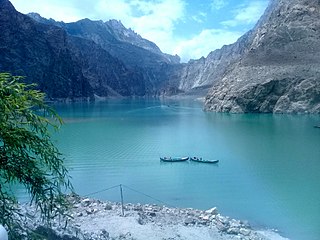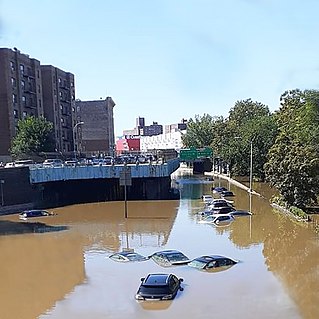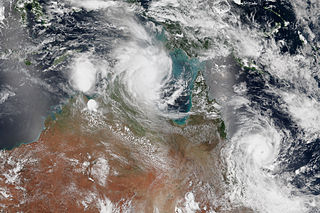
A cloudburst is an extreme amount of precipitation in a short period of time, sometimes accompanied by hail and thunder, which is capable of creating flood conditions. Cloudbursts can quickly dump large amounts of water, e.g. 25 mm of precipitation corresponds to 25,000 metric tons per square kilometre. However, cloudbursts are infrequent as they occur only via orographic lift or occasionally when a warm air parcel mixes with cooler air, resulting in sudden condensation. At times, a large amount of runoff from higher elevations is mistakenly conflated with a cloudburst. The term "cloudburst" arose from the notion that clouds were akin to water balloons and could burst, resulting in rapid precipitation. Though this idea has since been disproven, the term remains in use.
Landslides in Malaysia are regular natural disasters in Malaysia which occur along hillsides and steep slopes.
Spera District is situated in the most southwestern part of Khost Province, Afghanistan. It borders with Paktia Province to the south and west, Shamal District to the north. The district is within the heartland of the Zadran tribe of Pashtuns. To the east it borders Nadir Shah Kot and Tani districts and Pakistan. The population is 21,500 people. The district center is the village of Spera, situated in the central part of the district.

Pakistan's climate is a continental type of climate, characterized by extreme variations in temperature, both seasonally and daily, because it is located on a great landmass north of the Tropic of Cancer.

Attabad Lake is a lake located in the Gojal region of Hunza Valley in Gilgit−Baltistan, Pakistan. It was created in January 2010 as the result of a major landslide in Attabad. The lake has become one of the biggest tourist attractions in Gilgit−Baltistan, offering activities like boating, jet-skiing, fishing and other recreational activities.

The global weather activity of 2010 includes major meteorological events in the Earth's atmosphere during the year, including winter storms, hailstorms, out of season monsoon rain storms, extratropical cyclones, gales, microbursts, flooding, rainstorms, tropical cyclones, and other severe weather events.
After heavy rains and flash floods in Pakistan, at least 71 people were killed and another 34 hospitalized. Rain started at night of Saturday, April 3, rainfall began to spur floods in the Khyber Pakhtunkhwa region in the northwest. Heavy rainfall is common in Southern Asia during the pre-monsoon season.

The 1992 India–Pakistan floods was a deadliest flood caused by a five days long heavy monsoon rains and severe weather that occurred on 7 September 1992 across the north-Pakistan of Azad Kashmir, North-West Frontier Province and Indian administered state of Jammu and Kashmir. Severe floods left more than 2,500 fatalities, including 2,000 deaths in Pakistan administered state, 300 in Punjab province, and 200 in India administered state with several other missing. The floods swept away more than 12,672 villages and several people were buried alive due to landslides near mountains. Punjab, that shares its borders with Azad Kashmir, suffered a heavy agriculture loss in its economic history.

Very Severe Cyclonic Storm Titli was a deadly and destructive tropical cyclone that caused extensive damage to Eastern India in October 2018. Titli was the twelfth depression and fifth named storm to form in the 2018 North Indian Ocean cyclone season. Titli originated from a low pressure area in the Andaman Sea on October 7. With warm sea surface temperatures and low wind shear, the low developed into a depression on October 8 in the central Bay of Bengal. It was tracked and followed by the India Meteorological Department (IMD), which also issued warnings and notices for the public. Titli continued to intensify at it moved toward the southeast Indian coast, becoming a very severe cyclonic storm, equivalent to a minimal hurricane on the Saffir–Simpson scale. It attained the intensity at the same time Cyclone Luban in the Arabian Sea was at the same intensity, marking the first instance since 1977 of simultaneous storms. The IMD estimated peak winds of 150 km/h (90 mph), while the American-based Joint Typhoon Warning Center (JTWC) estimated peak winds of 195 km/h (120 mph). Late on October 10, Titli made landfall in Andhra Pradesh, and it quickly weakened over land as it turned to the northeast. It degenerated into a remnant low on October 12.

The following is a list of weather events that occurred in 2021. The year began with La Niña conditions. There were several natural disasters around the world from various types of weather, including blizzards, cold waves, droughts, heat waves, tornadoes, and tropical cyclones. In December, powerful Typhoon Rai moved through the southern Philippines, killing 410 people and becoming the deadliest single weather event of the year. The costliest event of the year, and the costliest natural disaster on record in the United States, was from a North American cold wave in February 2021, which caused $196.4 billion (USD) in damage; the freezing temperatures and widespread power outages in Texas killed hundreds of people. Another significant natural disaster was Hurricane Ida, which struck southeastern Louisiana and later flooded the Northeastern United States, resulting in $70 billion (USD) in damage. December saw two record-breaking tornado outbreaks, only four days apart from each other.
The following is a list of weather events that occurred on Earth in the year 2022. The year began with a La Niña. The most common weather events to have a significant impact are blizzards, cold waves, droughts, heat waves, wildfires, floods, tornadoes, and tropical cyclones.
Events of the year 2022 in Pakistan.

The following is a list of weather events that occurred on Earth in the year 2014. There were several natural disasters around the world from various types of weather, including blizzards, cold waves, droughts, heat waves, tornadoes, and tropical cyclones. In September, floods in India and Pakistan killed 557 people. The costliest single event was Typhoon Rammasun, which killed 225 people and left over US$8 billion in damage when it moved through the Philippines, China, and Vietnam.
In January and February 2022, landslides occurred in Colombia.

The following is a list of weather events that occurred on Earth in the year 2015. There were several natural disasters around the world from various types of weather, including blizzards, cold waves, droughts, heat waves, tornadoes, and tropical cyclones.
In 2022, major floods and landslides occurred in Brazil.
From January 31 to February 1, 2022, heavy rainfall impacted Ecuador, which caused multiple landslides, floods, and mudflows. A landslide in Quito, Ecuador, killed 24 people, injured 47 others, left nine missing, and collapsed at least nine houses. It was caused by the country's biggest rainfall in nearly 20 years, which fell on the capital.
In November 2002, two medium-sized earthquakes struck northern Pakistan, causing major damage in Baltistan region and killing 41 people.
Beginning in May 2022, deadly floods hit northeastern India and Bangladesh. Over 9 million people in both countries have been affected, and around 150 have been killed.








